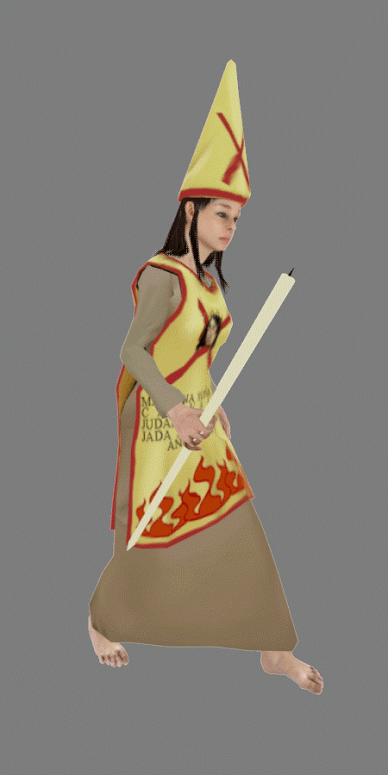Digital Auto De Fe

The Story of
Mariana Núñez de Carvajal
In February 1596, the 22 year old Mariana Núñez de Carvajal suffered a complete nervous breakdown during her ordeal and participation in an Inquisition trial. The young woman’s forced presence at an auto de fe in Mexico City led to her precarious mental state. Declared by the Inquisitors’ as too mentally unstable to stand trial at the time, she still found herself forced to bear witness to the burning at the stake of her mother, brother and sisters.[1]
Emotionally, physically and spiritually devastated by the traumatic events of having been forced to participate as a spectator to the macabre deaths of her family, Mariana did not escape the scrutiny of the Mexican Holy Office for long.
By the early spring of 1601, the 26 year old woman found herself imprisoned in the cárcel perpétua of the Inquisition and by the end of March, Mariana herself would succumb to the flames.
Although according to one of her captors, she had “died well in the spirit of Christ,”[2] her forced disavowal of her Jewish beliefs and customs, and the role that early modern religious intolerance played in the long and tortuous path that eventually lead her to the stake even after her reported sincere conversion to Catholicism, is just one of the most poignant examples of the violent clash of religions that made up the religious, political and social milieu of colonial Latin America.
What makes the story of Mariana’s eventual demise even more tragic is the very humiliating and punitive nature of the public act of faith she was forced to endure. Viewed by modern humanist scholars variably as either a didactic theatre of punishment and reprehension, or a attempted mimicking of the ultimate divine judgment of Christ over the damned sinners, what all can agree on is the fact that the Inquisition’s many autos de fe had as their purpose the use, manipulation and redirection of public space for the purpose of not only sentencing and punishing convicted heretics, but also as offering up the very human suffering and pain of the victims as clear warnings to all present to avoid the sins and temptations of falling into heresy.
As Michel Foucault so aptly wrote in his own seminal study on the nature of crime and public punishment, “The guilty person is only one of the targets of punishment. For punishment is directed above all at others, at all the potential guilty…”[3]

Even more disturbing to the modern scholar/ student /reader is the almost carnival nature of these public auto de fe ceremonies.[4]
Starting several days before the actual event, these ceremonies involved a massive number of indigenous, Spanish, and mixed caste workers, participants and spectators, who most often numbered in the thousands.
The day before these events, Nahua indigenous people, mixed-race mestizos, mulattos and other members of the similarly miscegenated casta categories, most often separated and isolated into various social and racially segregated districts throughout the city, all began to gather together in a rare opportunity for social and racial commingling, congregating in and around the central plaza of the capital city of the Kingdom of New Spain: Mexico City.
The bizarre spectacle that would take place on the date of the auto de fe, included many paradoxical sights, sounds, and smells. From indigenous and casta vendors selling food and other trinkets at concession stands among the crowds of people who thronged along the main thoroughfare of the city, to the solemn religious processions of the highest ranking clergy and political elite, the ceremonies of the auto de fe exhibited and exemplified the paradoxical circumstances of a segregated multi-ethnic, and multi-cultural colonial society.
The event itself became imbued with ritual, political and social signs and symbols that served to reinforce the colonial religious, social, racial and political hierarchies.

[1] For a complete study of the fate of Mariana’s family see Martin Cohen, The Martyr: Luis de Carvajal, a Secret Jew in Sixteenth Century Mexico, University of New Mexico Press, 1973, pp. 211-226.
[2] Relación del auto general de la fe celebrado el 25 de Marzo, 1601, AGN, Inquisición, Legajo 1510.
[3] Michel Foucault, Discipline and Punish: the Birth of the Prison, Reprint, Vintage Books, 1977, Part 2, Chapter 2, pages 108.
[4] Maureen Flynn, “Mimesis of the Last Judgment.” Sixteenth Century Journal Vol. 22, No. 2 (1991): 281-284.